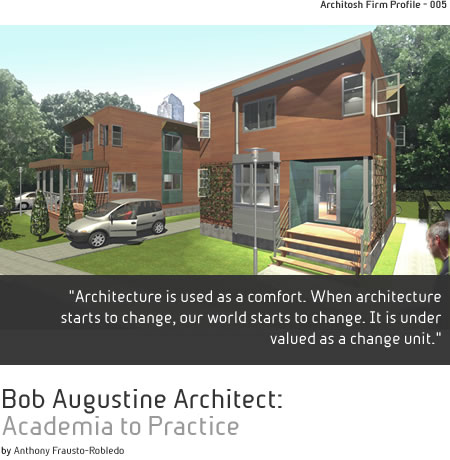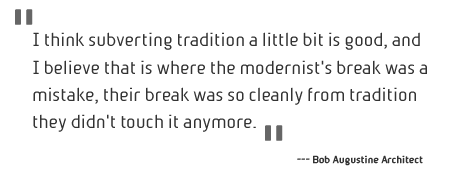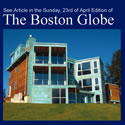|

 |
 |
Boston-based
architect Bob Augustine has spent a great
portion of his
professional life in architecture within the
academy, developing and teaching the instrumental
Thesis Seminar program at the Boston Architectural
College. He is now an associate professor at
Wentworth Institute's architecture program.
But since leaving his long post at the nearby
BAC, Bob has been engaged in a fundamental
shift where practice is now a large portion
of his professional life, and where his newfound
pursuits and passions are thrusting him into
a critical debate raging within his own work:
tradition versus modern, comfort versus social
responsibility.
And
it's all happening within the beltway of architecturally
conservative Metro Boston. This
introspective conflict is the stuff
he literally encouraged hundreds
of students to engage in when developing their
thesis programs.
Now
he's working on a thesis of his own -- in his
practice -- that has earned him spotlight attention
in the Boston
Globe Magazine and World Architecture
News.
This
winter I had a chance to sit down with Bob -- who
is both an old friend and former professor
of
this author -- and discuss the new attention
and critical praise he's been receiving for his
latest work. |
|
Contents
Academia
to Practice
Boston
Architecture
The
Market for Modernism
The
Creative Class: Luxury and Desire
Green
Design and Reconfiguring Tradition
Comfort
versus Responsibility
ArchiCAD
and the Mac
- Toolbox
-
- Mac
OS X
- Safari
- iTunes
- iPhoto
- QuickTime
- ArchiCAD
- Architerra
- Archiforma
- LightWorks
- Adobe
Creative Suite
- 2.16Ghz
MacBook Pro
- Apple
Cinema Display
- HP
DesignJet 130 printer
- HP
C7100
- Web
Site
-
- Bob
Augustine Architect
|
Academia to Practice
AFR: How
was your transition from the academic world to the world
of practice? What was the shift like from teaching thesis,
concepts, theories to the realm of practice?
Bob
Augustine (BA): Well
because so much of my background was in practice before
my academic days, it wasn't like a jump, per se,
it was more like a stutter step -- like going back
to where it was before. The first thing I brought to
my client was a quote from Daniel Libeskind... "tradition
is a veiling of fiery origins." I
always loved that. The client, who was an artist, said, "yes,
let's go for it." There was this immediate
connection, about ideas and the possibilities of architecture.
Do
you think that is a rare client?
(BA): Yes,
there was a lead into it since the client was an artist
and his wife a graphic designer. But I found that it
is true with other clients as well, even with my contractor-developer,
Duncan. Duncan is interested in a different kind of architecture,
not building the traditional "McMansions".
He is someone willing to take a risk.

Can
you tell me a bit about this collaboration you have with
your builder-developer?
(BA): It
is not the traditional design-build relationship, but
is is a collaborative relationship. It makes sense that
we go on this path together a bit
to see where the work goes.
It works well for me. In practice versus academia there
is a lot more concern about codes, reviewing agencies,
building departments, responding to square footages,
open space, and adjacency. Duncan's experience helps me navigate
through those issues. At the same time I can hand over
the baton and share some of the design work with him
and his crew when he starts building and they start working
closely with the client on a day to day basis.
You
bring up an interesting aspect about practitioners who
teach. Before you were working with students getting
them to try all these things out, conceptually, not necessarily
grounded in the realities of the building code, historical
architectural review board—these type of things
that typically don't get confronted in the academic
studio. This is often hard to reconcile on a certain
level.
(BA): This
is interesting. You are raising the question: how much
can you still rely on, or how much can you energize the
idea of search, in the work, when all of a sudden you
are building buildings? You start to fall back on old
reliable patterns.
Yes,
that's right.
(BA): I
was aware of it but I still think I was able to keep
some of the meaning. We could talk about the meaning
I still have in my work. I think the work is really about
tradition and not just modernism. Everybody looks at
it and says that it is modern design but not really,
that is why Libeskind's quote is so interesting. I think
subverting tradition a little bit is good and I believe
that is
where the modernist's break was a mistake,
their break was so cleanly from tradition
that they didn't touch it anymore. They left it
for the post modernist to deal with.
 |
 |
 |
| Affordable
green housing proto-types (left), World Architecture
News "house of the month" winner (middle)
utilizes extensive use of copper and utilizes green
technology
sod on portions of the roof. The Boston Globe runs
feature titled 'Modern Love' about modern housing
that is challenging perceptions and acting responsible
to
energy
conservation
and the
environment (right). |
And
are you dealing with it?
(BA): My
work seems to go back to engage in traditional forms
again. Subvert may not be the best word to use for it,
but I think it kind of is. Reconfiguring traditional
roots is perhaps more appropriate. I like to think that
some of the work is sustainable, green, 2007.
next
page > | 1 | 2 | 3 | 4 |
|






![]()
![]()